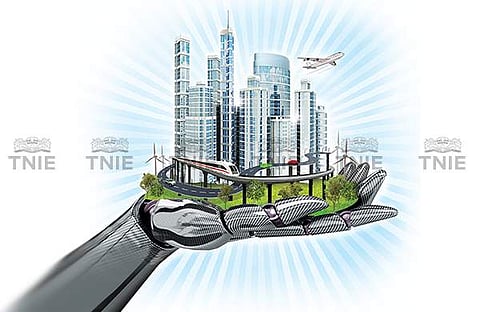

VIJAYAWADA: In a bid to tackle garbage menace, the Vijayawada Municipal Corporation (VMC) has entered into a Memorandum of Understanding (MoU) with Kumbakonam-based Zigma Global Environ Solutions Limited in the presence of Chief Minister N Chandrababu Naidu at Swachhata Hi Seva programme held at Indira Gandhi Municipal Corporation (IGMC) Stadium here recently.The garbage both biodegradable and non-biodegradable that got accumulated in the dumping yard without being segregated for the last two decades posed a challenge to the Vijayawada administration.
To overcome this problem, the civic body has switched to the biomining technology, which officials believe is much more efficient and the land would almost return to its original form. As it gives a dual benefit - effective disposal of waste and production of power from waste - the VMC has put the entire process on fast-track. The project is not only cost-effective but also helps eliminate methane production, unlike the so-called ‘sanitary landfill’ method earlier proposed by the VMC. As per the official estimates, the civic body has to spend Rs 14 crore to implement biomining project at Ajit Singh Nagar dumping yard. In this regard, the civic body has earlier earmarked Rs 9 crore fund through fixed deposit for the development of the dumping yard.
As part of the biomining process, the company will shift the 2.5 lakh tonnes of unprocessed waste that has been accumulated over the past few years at the 10-acre dump yard at Ajit Singh Nagar in the city in a span of 18 months.“We initially planned to convert it (the garbage hill) into a small park. But, now we have opted for biomining,” says sanitary inspector, who is in-charge of the dumpyard.Speaking to Express, Municipal Commissioner J Nivas said that biomining process is a popular solution for huge landfills.
While explaining the process, he said that it is a near-zero emission process where the dump hills can be cleared as if they never existed. He said required machinery would be installed near the garbage hill to segregate combustible and non-combustible materials with an automatic machine.
“Waste will be segregated by a machine and combustible materials like plastic and wood would be sent to cement factories to use them as alternate fuel. While the non-combustible materials like sand, soil and other degraded food waste will be dumped again in the given land as they can easily decay and maintain the carbon content,” he added.